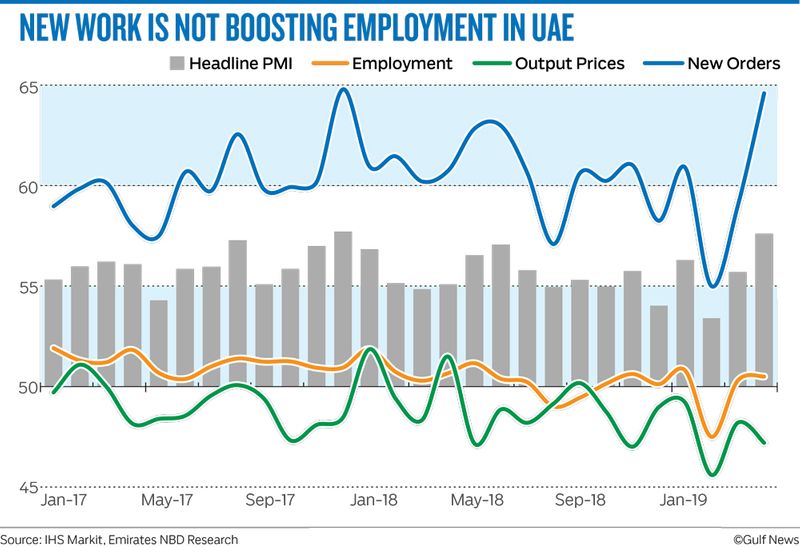Dubai: The UAE’s purchasing managers’ index (PMI) for April rose to 57.6 from 55.7 in March, the highest reading since December 2017.
The headline index signals an improvement in business conditions driven by higher output and new work. Output rose by the most in more than four years with nearly 37 per cent of firms surveyed reporting higher output/business activity last month relative to March.
The quantity of purchases increased sharply in April, consistent with higher output and new orders. Stocks of inventory have also increased since the start of the year.
“The improvement in the volume of activity and new order growth last month is encouraging. However, with firms still competing on price, there is still a reluctance to boost hiring and we haven’t seen a meaningful improvement in job growth. Household consumption is likely to remain constrained in the absence of job and or wage growth,” said Khatija Haque, Head of MENA Research at Emirates NBD.
New orders rose at the fastest rate since December 2017. Panellists reported improving demand conditions, although this was helped by further price discounting. External demand improved as well last month, with businesses reporting increased orders from Saudi Arabia, Oman, Kuwait and Europe.
Higher new orders combined with a number of ongoing projects led to a substantial rise in business activity in April. Moreover, the rate of expansion was the fastest since January 2015. Some panellists reported that promotional efforts had helped to boost activity.

The offer of discounts to customers led to a seventh successive monthly fall in output prices, and one that was more marked than seen in March. Companies were able to reduce charges thanks to a relative lack of cost inflationary pressures. Both purchase prices and staff costs rose only marginally in April.
Selling prices declined on average for the seventh month in a row in April, as firms offered promotions to attract new business in a competitive marketplace. However, input cost pressures eased last month as well, providing some relief for firms’ margins.
Despite the rise in the volume of activity and new orders in April, job creation was marginal. Just over 3 per cent of panellists reported increased employment in April, on the back of increased workloads, while 0.7 per cent of firms reported a decline in employment last month. Most firms have kept headcount unchanged over the last couple of months, as they attempt to limit operating expenses. Staff costs were largely unchanged in April.
“The quantity of purchases increased sharply in April, consistent with higher output and new orders. Stocks of inventory have also increased since the start of the year, although at a much slower rate than overall purchasing activity, suggesting that firms are becoming more efficient in their inventory management,” said Haque.
Business optimism reached a series high in April, with the future output index rising to 90.8. More than 80 per cent of firms expected their output to be higher in a year’s time, while none predicted a decline.








